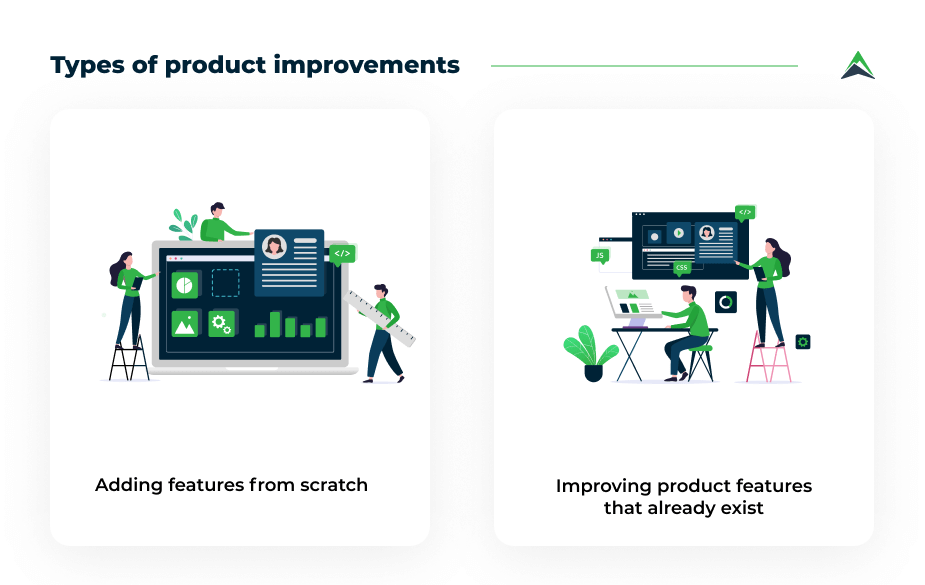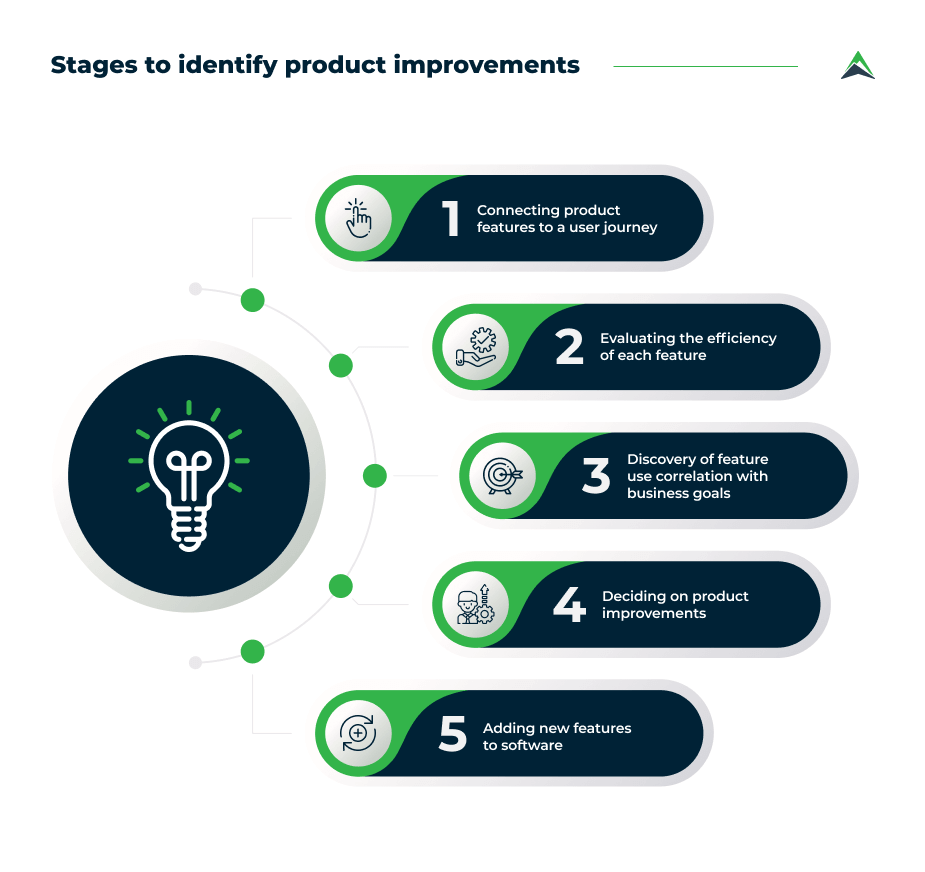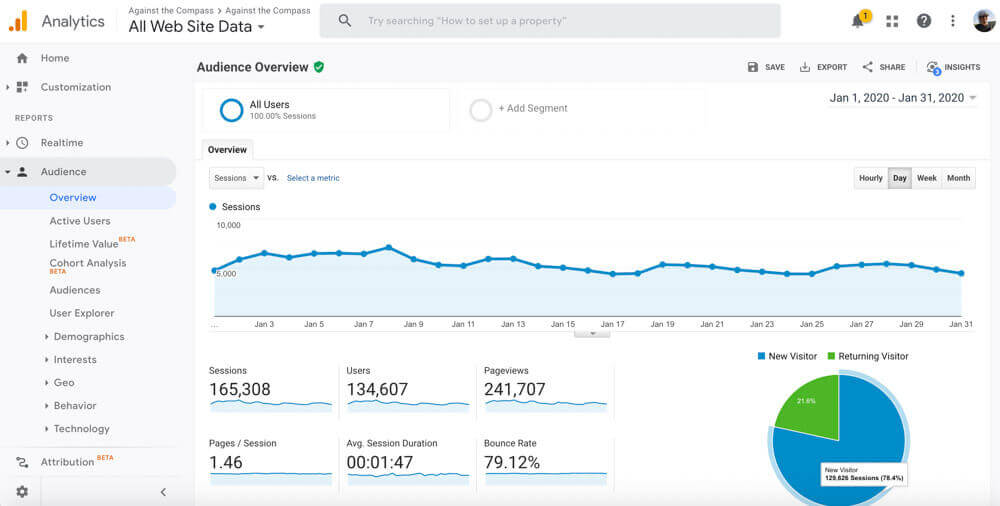Now that you’ve entered the market with your new software product, ran user acceptance testing, and received feedback, you can finally get a clear vision of the product features you should add to make your app work even better. At this point, your app should already have a pool of loyal users.
Also, you’ve probably already received several rounds of funding from investors. By now you’re all set for adding new features to your app and introducing product updates.
So how do you approach product improvements? Deciding on the new features, and introducing product changes is quite complex. In this article, we will give you a comprehensive guide on adding new features to software and announcing product updates. Read on to learn more!
What is product improvement
Product improvement is a continuous process, which goes on through the entire application lifecycle. As the app evolves, so does the set of features. Ultimately, the decision on which features to add or improve depends on the feedback from the product users.
There are, essentially, two types of product improvements: adding features from scratch and improving product features that already exist. Deciding on adding new features involves using questionnaires and customer interviews, identifying product use patterns, and listening to what users say about your product. Learning which features to improve is more complex: it’s learning from user feedback, which features they rarely use and which features they never even knew existed.

Based on these findings, there are several opportunities for product improvements. Identifying the ones that can be improved should be your primary focus, and here’s how.
Identifying product improvement opportunities
Deciding on which product features to add or to improve requires time and careful consideration. You don’t just come up with new features randomly – you have to envision every step of the customer journey to set you on the right track.

Identifying product improvements includes five stages:
1. Connecting product features to a user journey
In every app, there will be features that your users particularly enjoy and the ones they never knew existed.
Most of your application users fall into several categories:
- signed up,
- active,
- engaged,
- loyal,
- paying, and
- satisfied.
Rank your features depending on how effectively they help to propel your customers further towards the ‘satisfied user’ category. To do this, you will have to understand the sequence of your customers’ steps as they use your app and the typical flow of their actions.
If you place these patterns along a timeline, you will be able to see at which point users typically drop off and when they experience difficulties. Normally, there will be several types of user journeys. Choose the one that users take more frequently to identify opportunities for product improvement.
2. Evaluating the efficiency of each feature
Not every app feature is equally useful. Even though people may use a certain feature quite often, they may not be using it for its intended purpose. Your next step should help you understand exactly how successful your product features are.
Completing this step will help you understand how, why, and for what purpose customers are using particular application features. You also should be able to evaluate if the features successfully serve their original goal.
At this point, you may need a set of specific tools to collect customer feedback. You can use tools like Zendesk to help you complete this step and update any product features.
3. Finding out how feature use correlates with your business goals
Even if you find a particular feature successful, it doesn’t automatically mean that it helps your app achieve the business goals you’re aiming for. There’s a correlation between app features that customers use and the conversion rates.
However, this correlation is not linear, and simply identifying that “customers who used this feature converted” is not enough. Ideally, you have to take into account people who converted without using particular features, and people who used them and did not convert.
To identify this correlation, you will need a basic understanding of statistics for estimating how the use of a specific feature translates into higher conversion rates. With the help of analytics tools, you will be able to understand how the combined use of features mapped out in your user journey leads to fulfilling your business goals such as higher engagement and conversion rates.
4. Deciding on product improvements
Now that you’ve got all these correlations figured out, you should introduce product changes that will be both relevant to customers and help you reach your business objectives. When it comes to improving existing product features, there are three types of improvements you can introduce: adoption improvements, deliberate improvements, and frequency improvements.
Adoption improvements concentrate on helping users adopt a particular feature. These types of improvements are relevant if research shows users will benefit from it and that the use of this feature will result in more engagement and conversions. To introduce adoption improvements, eliminate what hampers the feature’s adoption:
- enhance the feature with more capabilities,
- enable users to find the feature more easily, and
- understand what prevented customers from using this feature.
Deliberate improvements are all about making the feature that customers already appreciate even better. This type of improvement involves preliminary research: you will have to find out what customers love about this feature to be able to make it bring more value.
Introducing frequency improvements makes sense if your research has indicated that the frequent use of a particular feature will result in more conversions. Your goal lies in helping your customers increase the number of feature usages.
5. Adding new features to software
Adding completely new features is often a risky endeavor. Even if you run customer surveys and ask them about new features they would love to see, the outcome can be entirely different.
On the bright side, adding new product features gives you something newsworthy to announce, helps you create publicity and win new customers. Most importantly, before you launch a new feature, you will have to run a full-scale feature release campaign.

Feature announcement strategies
Making sure your new or improved product features get all the attention they deserve is a step by step process. You will have to carefully outline your feature announcement strategy and make sure you target the right audience through relevant channels.
Here’s a list of steps you can take to help your product updates get enough publicity and recognition.
Pre-launch
Starting early with feature announcements is always a good idea. Begin your feature announcement campaign with a teaser describing how the new feature will enhance your software product. Your message should be informative and memorable. Ideally, it should include
- a description of a new feature along with the benefits it will bring,
- a picture or a video illustrating how it works, and
- an intriguing message leaving users in anticipation of further updates
However, users may get tired if they get to many “coming soon” messages. As a rule of thumb, one or two messages will be enough to keep them engaged.
Make sure your users can easily learn about new features
The process of learning about new features should take place naturally and integrate into users’ regular daily activities. Identify the most convenient way in which your users will learn about your features updates:
In-app environment
For those who use your app on a regular basis, an in-app environment will be the best medium for learning about product updates. While they are unlikely to return to your app just to see what’s new after receiving an email, they would welcome an in-app notification about its new capabilities.
In Google Analytics, for example, user prompts and tooltips are delivered to users directly into the app’s interface, so there’s no need to open documentation or consult a helpdesk.
At the same time, you shouldn’t ignore your less engaged users and prospects. Do target other mediums to get more exposure.

Company blog
A company blog with high traffic ranking is surely a medium where you should make a feature release announcement. Its readers are probably already using your products, so notifying them via your blog is an excellent idea.
Asana for Slack is an example of using a company blog to announce updates. When the Slack app enabled users to manage Asana tasks without leaving the Slack chat, it published a blog post about how to use this feature and describing its value.
This tried and true method still hasn’t lost its relevance. Emailing your customer base to make feature release announcements is a great means of making your message heard.
For example, Wistia, a video marketing app, sends update announcements directly into the users’ inbox. The email has a feature description, a video on feature’s users and a call to action encouraging users to partake in the product testing.
There are three ways of approaching an email campaign:
- sending the same message to every person on your list,
- splitting your audience into segments depending on their engagement and phrasing a different message for each segment, and
- reaching out individually for each user.
Personalized communication may be time-consuming, but may be totally worth the effort. If you have an account manager who can handle this task, you may eventually get maximum user engagement.
Social media
Almost everyone uses some kind of social media these days, so posting a feature update announcement on social media platforms will guarantee publicity and exposure. The types of posts you can use for feature announcements fall into three categories: informational, educational, and aimed at boosting user engagement.
For example, you can use social media to run competitions and suggest prizes for recommending your product to friends. Last but not least, consider the possibility to launch paid social media ads to advertise your product updates.
Webinars
Educational initiatives with hands-on examples of how your new or improved feature works can be an excellent part of your feature announcement strategy. For example, you can run a free webinar, with a step-by-step guide on how to use your new feature and follow it by online quizzes for knowledge assessment.
This type of engagement will instantly demonstrate how your new feature adds value to your product. Webinars are also capable of boosting product adoption rates and increasing the feature use frequency.

Press-releases
This conventional PR method may work in your community or your industry, especially if the impact of your new feature has some revolutionary potential. A skillfully crafted press-release can help you gain free publicity in industry-specific media and attract attention to your product, especially if it’s unique, or environmentally friendly.
Tailor your message to different user groups
The needs, tastes, and preferences of your users differ, sometimes quite significantly. You can split your users into different user segments and target each segment separately via relevant mediums and channels. You can also phrase your message differently when addressing different user groups.
Don’t overlook the WOW factor
Make sure you prepare a truly spectacular announcement for your most significant app features. Plan and execute pre-launch communication activities and make a loud new feature announcement when the feature is fully functional. It’s also a good idea to have a select group of users join the beta testing stage and take part in feature evaluation.
Introduce new compelling features instead of features you plan to remove
As your product evolves, you may decide to remove some of its features. Needless to say, some people may be unhappy with your decision, especially if they’ve gotten used to this feature and its capabilities. To help them embrace changes, introduce new features instead of removed ones and focus on novelties rather than on outdated features in your communication.
Coach your sales reps
Inform every member on a sales team about the specifics of new or improved features that you plan to introduce. Chances are, these features will be exactly what attracts new customers to your product. Make sure your salespeople are ready to talk about the features’ benefits, how they integrate with existing features, which terms they should use when talking about it, and how it affects pricing.

Final thoughts
To introduce product changes in a way that will facilitate user onboarding and drive product adoption you need a full-fledged feature announcement strategy.
By the time you’ve completed all the steps mentioned above, you’re not done yet: after the feature launch, concentrate on collecting and processing user feedback. This can be by far more effective than running lengthy and expensive surveys. Every user reaction to a new feature contains valuable info that will help you introduce further improvements and updates.
Need a helping hand with introducing product changes? At Eastern Peak we can help you hone your feature announcement strategy. Contact us now for a free consultation!
Read also:


